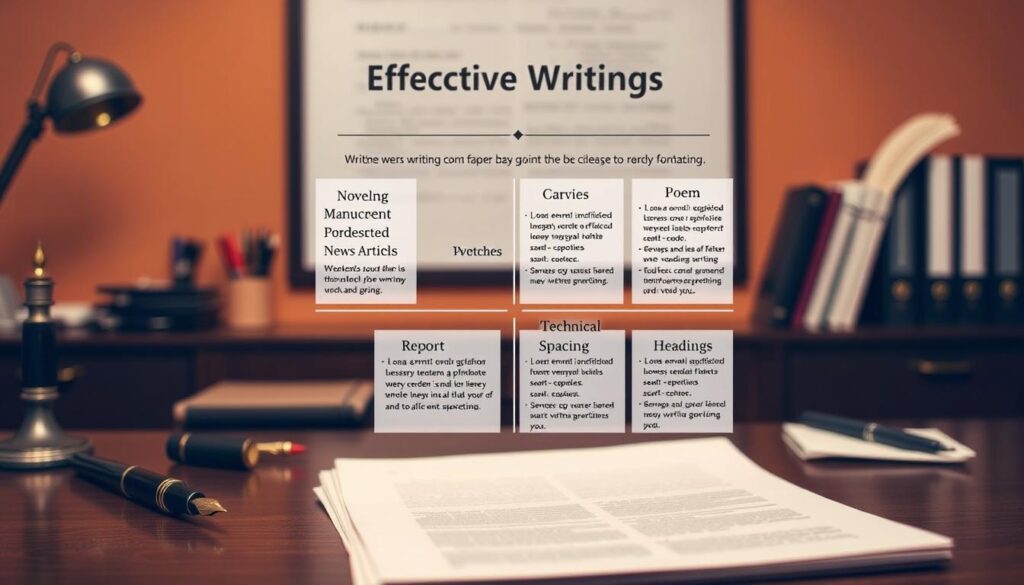Physical Address
304 North Cardinal St.
Dorchester Center, MA 02124
Physical Address
304 North Cardinal St.
Dorchester Center, MA 02124

Professionals across industries use portfolio pieces to demonstrate their expertise. These tangible examples let editors or hiring managers see your abilities firsthand, moving beyond bullet points on a resume. Whether it’s a blog post, technical manual, or creative project, your chosen work becomes proof of what you can accomplish.
Different roles require varied types of content. Marketing teams might prefer snappy ad copy, while publishers often seek long-form articles. Technical fields value clear documentation that simplifies complex information. The best selections align with the job’s specific needs while highlighting your unique voice.
Think of these materials as your career storytellers. They bridge the gap between claims and reality, showing rather than telling your skills. A well-crafted example can outweigh years of listed experience, making it essential for landing opportunities.
Strong portfolio pieces act as your professional fingerprint, revealing how you solve problems through words. They’re not just finished products—they demonstrate your research process, structural logic, and ability to polish rough ideas into clear messages.
Every sample should mirror the skills required for your target role. A technical manual excerpt highlights precision, while a blog post shows conversational flair. Look for opportunities to showcase editing prowess: clean formatting and error-free text prove you refine your work thoroughly.
Your chosen pieces demonstrate structural thinking. Do you break complex topics into digestible sections? Use headers to guide readers? These choices reveal how you organize information—a critical skill employers value.
Authenticity matters. Mimicking styles that don’t fit your voice creates mismatched expectations. If you thrive in witty marketing copy, avoid stuffing your portfolio with academic papers. Consistency between your samples and real-world output builds trust.
Industry standards also shine through. Digital content might feature SEO optimization, while journalism pieces adhere to AP style. These details show you understand the rules before bending them creatively.
In today’s competitive job market, demonstrating your abilities goes beyond resumes. A writing sample serves as proof of your communication expertise, letting employers see your work rather than just hear about it. Unlike cover letters that list qualifications, these documents display how you structure ideas, engage audiences, and solve problems through words.
Modern hiring managers rely on these materials to cut through generic claims. For roles requiring emails, reports, or creative content, your sample becomes a universal language. It shows whether your style matches company needs, regardless of academic background or prior job titles.
| Aspect | Cover Letter | Writing Sample |
|---|---|---|
| Purpose | Describes skills | Demonstrates skills |
| Content | Career highlights | Completed work |
| Impact | Creates interest | Proves capability |
| Evaluation | Subjective | Tangible |
Digital communication demands make these examples vital across industries. Tech startups might analyze coding documentation, while media firms assess storytelling flow. Strong samples level opportunities for self-taught professionals and Ivy League grads alike.
For job seekers, polished work builds credibility before interviews. Employers gain confidence seeing real-world results instead of hypothetical scenarios. This mutual clarity reduces mismatched expectations, creating better long-term fits.
Crafting a standout portfolio piece starts with one question: Who needs to connect with this work? Your writing sample must speak to two audiences simultaneously—the hiring team reviewing your application and the end readers consuming the content.
Job descriptions often hide clues about audience preferences. Look for adjectives like “actionable” or “casual” that reveal desired tones. These keywords act as breadcrumbs leading to the employer’s ideal reader profile.
Start by exploring the company’s digital footprint. Analyze their blog posts for recurring themes. Scroll through social media comments to discover what questions followers ask. This reveals unmet needs your sample could address.
Competitor research provides another angle. Compare how rival brands structure their articles. Notice gaps in coverage or styles that resonate better. This dual perspective helps you craft content that fits industry norms while offering fresh value.
Demographic details matter less than psychographic insights. Focus on what keeps your audience awake at night. Are they executives needing quick summaries? Parents seeking practical tips? Tailor complexity and examples accordingly.
Your final piece should balance employer expectations with authentic voice. A marketing sample might blend data-driven arguments with relatable stories. Technical documentation could showcase clarity through numbered steps and visual aids.
Remember: Audience analysis isn’t about mind-reading. It’s strategic empathy that makes your writing sample impossible to ignore.
Your career path determines which portfolio pieces open doors. A tech startup might value concise API documentation, while a magazine editor seeks vivid storytelling. Treat each submission like a tailored outfit—cut to fit the job’s exact measurements.

| Industry | Preferred Sample Type | Key Traits |
|---|---|---|
| Publishing | Chapter excerpts | Voice consistency |
| Marketing | Campaign copy | Conversion focus |
| Technical | User guides | Clarity under complexity |
Scour job postings for verbs like “develop” or “analyze”—they hint at desired skills. Three recent blog posts might impress a content agency, but one polished white paper could win a corporate contract.
Early-career professionals should showcase range through 2-3 varied pieces. Seasoned writers might highlight specialized expertise with targeted examples. Always remove outdated work—your portfolio evolves as your career grows.
When adapting existing pieces, update statistics or swap industry jargon. For radically different roles, create fresh samples that mirror the employer’s tone. Strategic selection proves you understand their world—and already speak its language.
Crafting standout portfolio pieces requires methodical planning. Follow this roadmap to transform raw ideas into polished work that captures attention and proves your capabilities.
Start with time-boxed idea generation. Set a 25-minute timer and jot every relevant concept without filtering. Job descriptions make excellent springboards—circle action verbs like “develop” or “optimize” to spark topic ideas.
Convert your best concept into a skeleton outline. Use this framework:
| Section | Purpose | Word Limit |
|---|---|---|
| Introduction | Hook readers | 50-75 words |
| Core Argument | Demonstrate expertise | 150-200 words |
| Examples | Show practical application | 100 words |
| Conclusion | Memorable takeaway | 50 words |
Let drafts cool for 24 hours before revising. First passes should address structure:
Final edits focus on precision. Replace vague phrases with specific data. Read aloud to catch awkward phrasing. Tools like Grammarly help, but manual reviews catch context errors algorithms miss.
Remember: Great samples evolve through multiple iterations. Each revision brings you closer to work that feels effortless—the hallmark of professional writing.
Mastering genre-specific formatting transforms good samples into career-launching tools. Each industry values distinct structural approaches that signal your professional awareness. Let’s explore techniques to make your work shine in editorial and marketing contexts.
News pieces thrive on the inverted pyramid structure. Start with a punchy lead answering who, what, when, and where. “City Council approved a $2M park renovation Tuesday amid resident protests” immediately grounds readers.

Follow with supporting quotes from key stakeholders. Attribute statements properly using AP style guidelines. Balance perspectives—include both official statements and community reactions. Close with a resonant quote that encapsulates the story’s impact.
Marketing materials demand strategic scannability. Use headers containing target keywords like “5 Budget-Friendly Home Renovation Hacks.” Answer core questions in the first 100 words before diving deeper.
Break complex ideas into numbered lists or comparison tables. For product descriptions, lead with benefits over features. Always include clear CTAs—”Download our free guide” works better than vague invitations.
Adapt vocabulary to audience knowledge levels. Tech brands might use “API integration,” while lifestyle blogs prefer “easy connectivity.” Formatting consistency—like bullet points for key specs—builds trust through predictability.
Effective samples blend readability with search engine savvy. Start by identifying questions your target audience types into Google. Answer these queries clearly in your opening paragraphs while naturally including primary keywords.
Tools like AnswerThePublic reveal related phrases real users search for. Sprinkle these terms throughout your content without disrupting flow. For example:
Search engines prioritize helpful, conversational text. Write for humans first—algorithms follow. Balance keyword density below 2% to avoid robotic-sounding prose.
Break long blocks of text with clear organizational markers. Use H2 tags for main sections and H3 for subsections. Include secondary keywords in headers like “Formatting Tips for Better Engagement”.
Structured content climbs search rankings faster. Bullet points and numbered lists help scanners find answers quickly. This formatting also increases chances of appearing in featured snippets—those coveted answer boxes at Google’s top.
Remember: Strong SEO makes your sample discoverable, while quality writing keeps readers engaged. Master this balance to create pieces that impress both hiring managers and algorithms.
Your portfolio becomes a career accelerator when strategically deployed. Treat it as a living document that evolves with each job opportunity. Update pieces to reflect industry trends and employer priorities.
Platforms like Contently or WordPress let you build sleek, navigable sites. Include 5-7 samples demonstrating range—case studies, blog posts, or project briefs. Add context explaining each piece’s purpose and impact.
Optimize for mobile viewing. Hiring managers often review applications on phones. Link your portfolio in email signatures and social media profiles to boost visibility.
Engage in niche communities like LinkedIn groups or writing forums. Share insights about your process when discussing others’ work—this demonstrates expertise without overt self-promotion.
During interviews, reference specific portfolio pieces when answering questions. “In my SaaS case study, I used data visualization to simplify API concepts” proves real-world application. Follow up with a tailored sample addressing the employer’s current challenges.